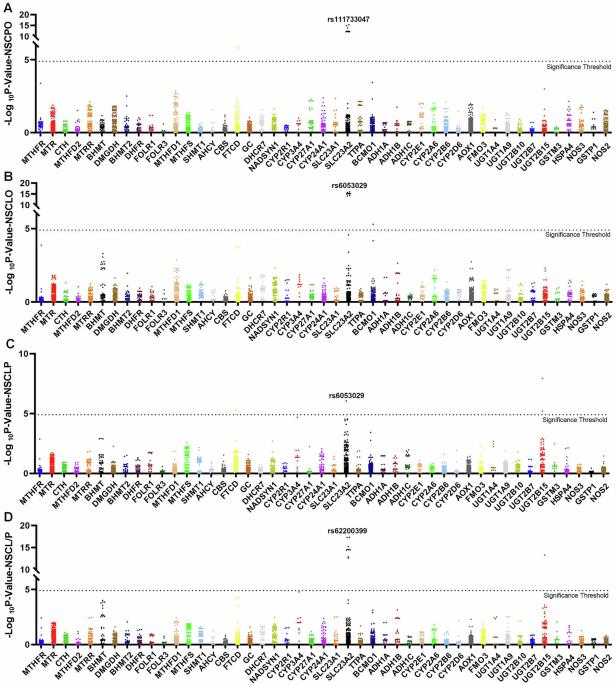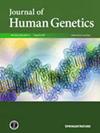新的易感基因SLC23A2通过PI3K-AKT-mTOR通路在非综合征性腭裂病因学中起作用。
IF 2.5
3区 生物学
Q2 GENETICS & HEREDITY
引用次数: 0
摘要
遗传因子和环境因子之间的生物学相互作用在非综合征性口面裂(NSOC)的病因学中起着重要作用,但研究很少。本研究从吸烟、饮酒、缺氧和维生素(包括维生素A、维生素B9(叶酸)、维生素C(抗坏血酸)、维生素D和维生素E)的代谢途径中选择了47个环境相关基因,检测其与NSOC及其亚型的相关性。我们发现一个新的基因SLC23A2,维生素C转运基因与非综合征性腭裂(NSCPO)显著相关(p = 3.25E-07, OR = 8.45, 95%CI:3.73-19.17)。SLC23A2表达于斑马鱼颅面区(24hpf ~ 120hpf),敲除SLC23A2 (SLC23A2 - mo)后,斑马鱼颅面区(48hpf)出现明显异常。敲低SLC23A2可诱导人胚胎腭间充质细胞系(HEPM)细胞内抗坏血酸(AA)降低,活性氧(ROS)增加,抑制细胞增殖,触发细胞凋亡,激活PI3K-AKT-mTOR信号通路,抑制自噬;在外源性ROS模拟物Sin-1诱导的高ROS水平HEPM细胞中添加AA后,ROS水平和凋亡率显著降低。在HEPM细胞或斑马鱼中敲除SLC23A2,它们对Sin-1变得更敏感,补充AA无效。综上所述,我们发现了一个新的NSCPO易感基因SLC23A2,它可能通过激活PI3K-AKT-mTOR通路,降低AA水平,增加ROS水平,诱导细胞凋亡,抑制自噬,在腭裂病因学中起作用。本文章由计算机程序翻译,如有差异,请以英文原文为准。

Novel susceptibility gene SLC23A2 functions via PI3K-AKT-mTOR pathway in etiology of non-syndromic cleft palate
The biological interactions between genetic and environmental modifiers play critical roles in the etiology of non-syndromic orofacial cleft (NSOC), but it is rarely studied. This study selected 47 environmental related genes from the metabolic pathways of smoking, drinking, hypoxia, and vitamins (including vitamin A, vitamin B9 (folic acid), vitamin C (ascorbic acid), vitamin D, and vitamin E), and test their associations with NSOC and its subtypes. We found that a novel gene SLC23A2, the vitamin C transporter gene is significantly associated with non-syndromic cleft palate only (NSCPO) (p = 3.25E-07, OR = 8.45, 95%CI:3.73–19.17). SLC23A2 is expressed in the craniofacial region of zebrafish (24hpf to 120hpf), obvious craniofacial abnormalities appeared in zebrafish (48hpf) when knock down the slc23a2 (slc23a2-MO). Knock down SLC23A2 in human embryonic palatal mesenchymal cell line (HEPM) induced decreased intracellular ascorbic acid (AA), increased reactive oxygen species (ROS), inhibited cell proliferation and triggered apoptosis, activated the PI3K-AKT-mTOR signaling pathway and inhibited autophagy; ROS levels and apoptosis ratio significantly decreased when we supplemented AA to HEPM cells with high ROS levels induced by Sin-1 (an exogenous ROS mimic). Knocked down SLC23A2 in HEPM cells or zebrafish, they became more sensitive to Sin-1, and AA supplementation was ineffective. In conclusion, we identified a novel susceptibility gene SLC23A2 for NSCPO, it may function by decreasing AA level, increasing the ROS levels, inducing apoptosis, and inhibiting autophagy through the activation of the PI3K-AKT-mTOR pathway in etiology of cleft palate.
求助全文
通过发布文献求助,成功后即可免费获取论文全文。
去求助
来源期刊

Journal of Human Genetics
生物-遗传学
CiteScore
7.20
自引率
0.00%
发文量
101
审稿时长
4-8 weeks
期刊介绍:
The Journal of Human Genetics is an international journal publishing articles on human genetics, including medical genetics and human genome analysis. It covers all aspects of human genetics, including molecular genetics, clinical genetics, behavioral genetics, immunogenetics, pharmacogenomics, population genetics, functional genomics, epigenetics, genetic counseling and gene therapy.
Articles on the following areas are especially welcome: genetic factors of monogenic and complex disorders, genome-wide association studies, genetic epidemiology, cancer genetics, personal genomics, genotype-phenotype relationships and genome diversity.
 求助内容:
求助内容: 应助结果提醒方式:
应助结果提醒方式:


